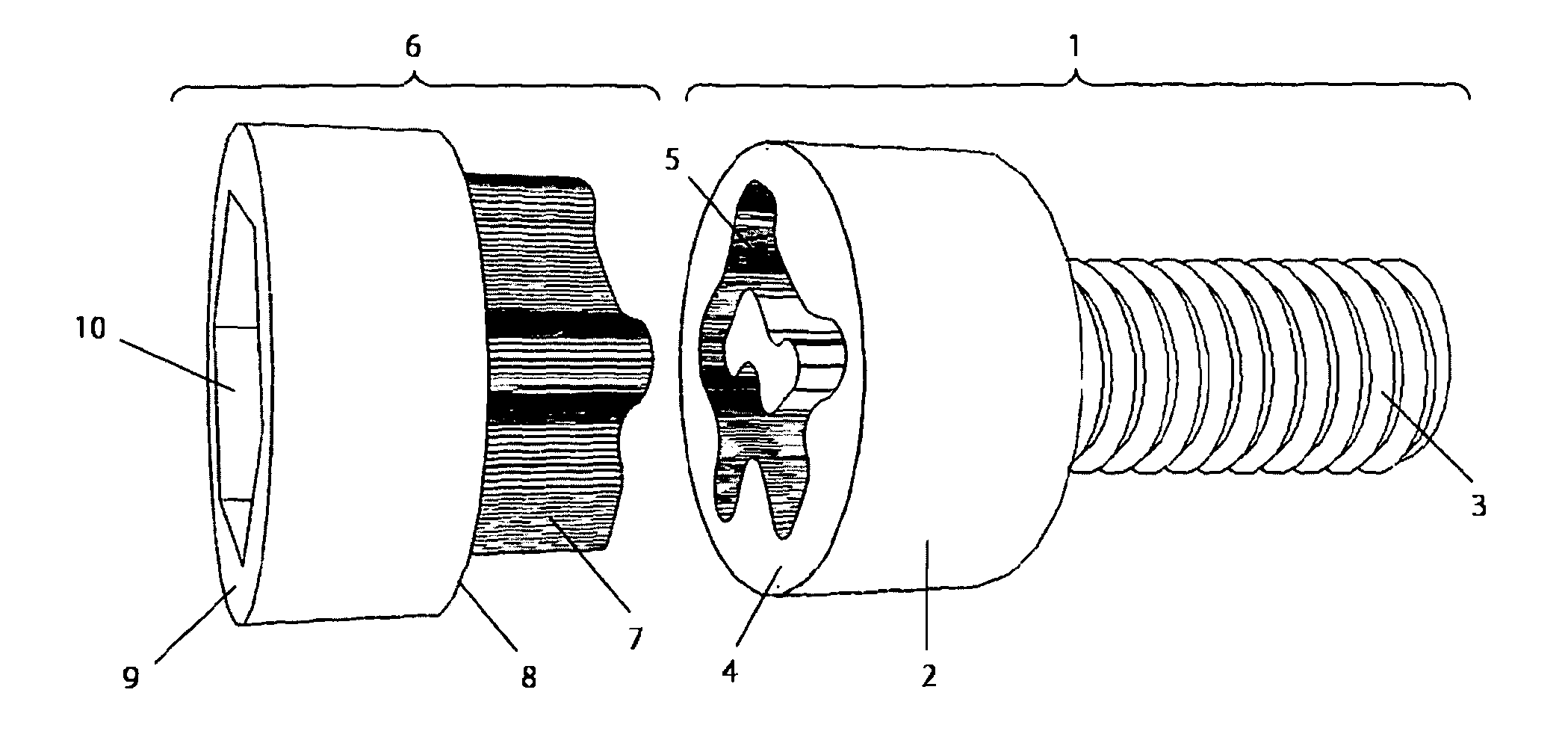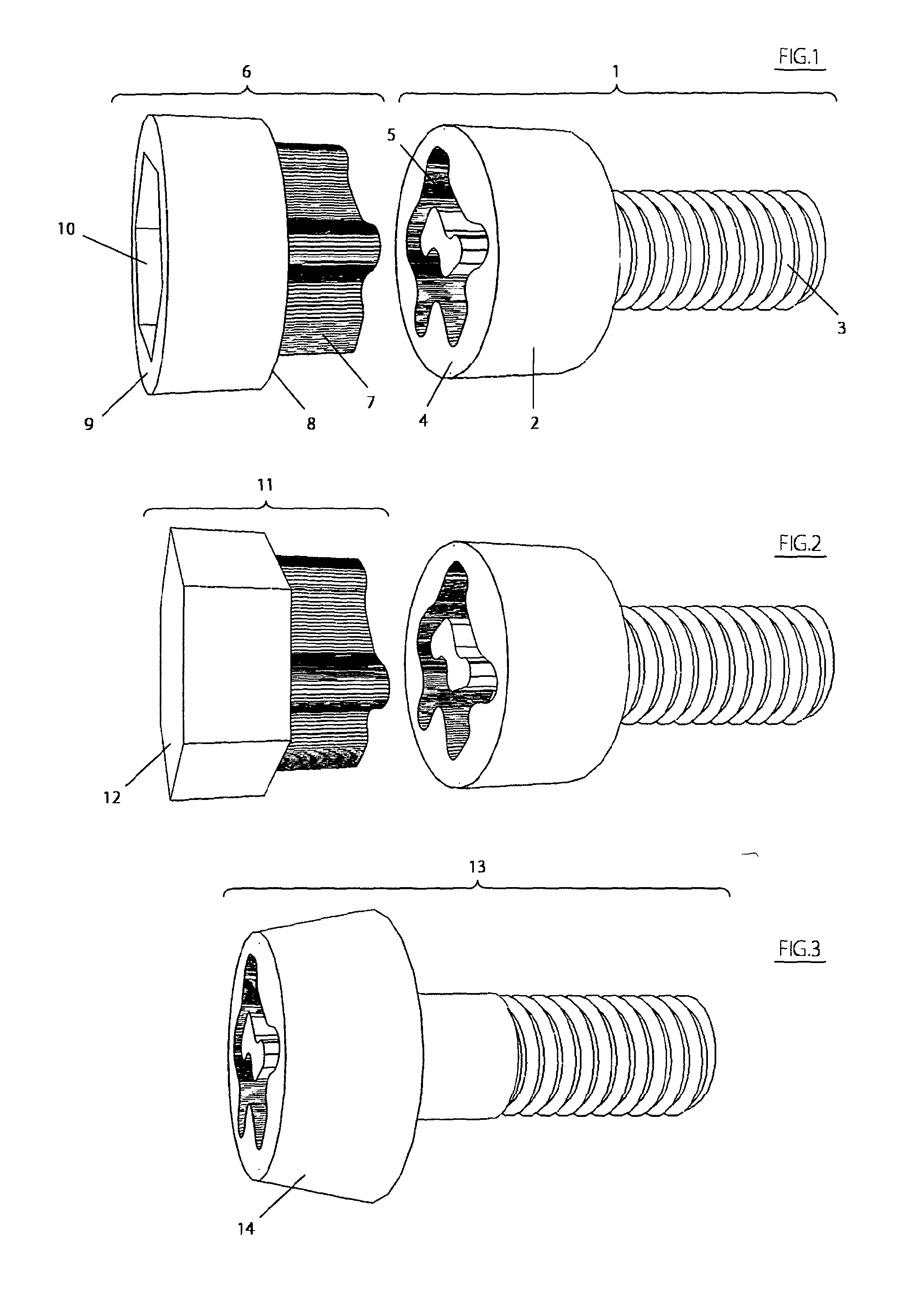However, these products are inadequate in the extent of the protection they offer.
In first seeking to replace the ‘quick release’ skewers with secure fasteners, the design of these security fasteners renders them inapplicable to securing many other component parts of the bicycle as the requirements for such fasteners differ to those of the ‘quick-release’ skewers.
Existing designs of fasteners are inadequate in providing sufficient security for the majority of components on a bicycle for a large number of cyclists.
This is since fulfilling any one or more of the fundamental requirements results in fasteners that require physical dimensions which render them inapplicable to the general application of securing all components of high proportional value to the bicycle frame, which includes the applications requiring a small
diameter fastener.
Although such designs make removal difficult, it is still possible to either rotate the nut using other tools such as adjustable in spanners,
needle nose pliers etc or to modify the fastener or create a proxy key using simple commonly available tools.
The
weakness of any such designs in a security application is that the risk exists of an unwanted rotation of the fastener being achieved by common tools which can be forced in to the recess and adequately engage the head to apply enough torque or the minor modification of the recess to accommodate such a tool.
However, it will be appreciated that using simple geometric designs provides a very limited range of possibilities for generating permutations for unique keys.
Such designs are widely commercially available and consist of a cylindrical central post within an otherwise standard key receiving recess such as a recess which fits a standard hex or ‘Torx’ key thus obstructing actuation by a standard and widely available key and also obstructing the
insertion of unauthorised objects such as bladed instruments.
The fifth category of fasteners are those in which the fastener is designed so that the external wall of the central body of the
threaded fastener provides the key receiving surface and is rendered inaccessible to gripping tools and thus unwanted removal by rotation using such tools by a coaxially rotating shroud or ring mounted on the central body.
Such designs still suffer from the same
weakness as the single tier recessed design in that it is possible that a bladed instrument may be inserted, possibly even across tiers, and successfully engage the fastener or alternatively, some other commonly available tool may be used to force a
mating or modify the recess to achieve such a
mating.
Additionally, security is not a function of successful replication of three tiers but reduces to the permutations contained in a single tier as a key obtained can have the lower tier(s) ground away thus rendering any fastener with a matching upper tier vulnerable to unwanted removal.
Thus, the main requirements of such a design are that firstly, all components of significant value can be secured to the bicycle to protect from unwanted removal and secondly, that the specific key is unique to the owner or as close to unique that the possibility of someone obtaining a replica key through legitimate means is inconceivable.
However, there are major shortcomings in existing designs specifically for this objective and for the same or other reasons existing designs of security fasteners inappropriate in the context of this application.
For some bicycle components, high levels of torque need to be applied to adequately secure the component to the frame due to the forces the component is subjected to in normal use which risk detachment of the component and the potentially dire consequences for the cyclist.
However, in the design of fasteners successful in hampering unwanted removal of these components, the general applicability of the fastener has been compromised.
That is to say, the same design cannot be used to secure other valuable components of the bicycle.
Commercially available products resulting from U.S. Pat. Nos. 6,341,927 and 5,950,506 successfully secure the seatpost to the bicycle frame yet the bicycle seat is still totally exposed to the risk of unwanted removal by anyone with a standard hex key.
The problem in achieving general applicability lies in the conflicting requirements of security (tamper-resistant design and uniqueness of key), a desire to protect the components of a single user's bicycle with one key, the ability to apply adequate torque to the fastener and for the fastener to withstand this torque and the desire for minimal physical dimensions of the fastener to facilitate general application and also for aesthetic considerations.
For example, the fastener taught in U.S. Pat. No. 6,341,927 is a relatively weak design from the perspective of torque application and hence requires a large enough
diameter to adequately perform its function as a fastener.
In so doing, it simultaneously negates the possibility of using the design to secure e.g. a seat to a seatpost in which the fastening bolt recesses into clamping mechanism used to secure the seat to the seatpost.
It will be appreciated by those skilled in the art that if this design used a fastener with a smaller
diameter face then it is likely that insufficient torque could be applied for the fastener to perform its function of securing safely a component to the bicycle frame and at the same time, the ability to generate a high number of permutations for specific key requirements would be lost.
The design of the nut is also relatively weak from the perspective of torque application and thus requires adequate physical dimension of the nut for the application of torque sufficient to safely secure the components as well as to permit generation of adequate specific key requirements.
This results in the same set of problems as in the previous example further compounded by the use of the rotating shroud external to the nut.
Thus, a design such as a fastener actuated by the
mating of a male member key with a curvilinear key receiving groove in the fastener's face which appears appropriate on paper is in reality inadequate in the context of the object of this invention as the material properties of the fastener and / or key and / or the minimum
cutting diameter of the tool used in production drastically reduces the number of permutations that can be generated for the design of the specific key and thus compromises the security aspect of the fastener.
 Login to View More
Login to View More  Login to View More
Login to View More 


